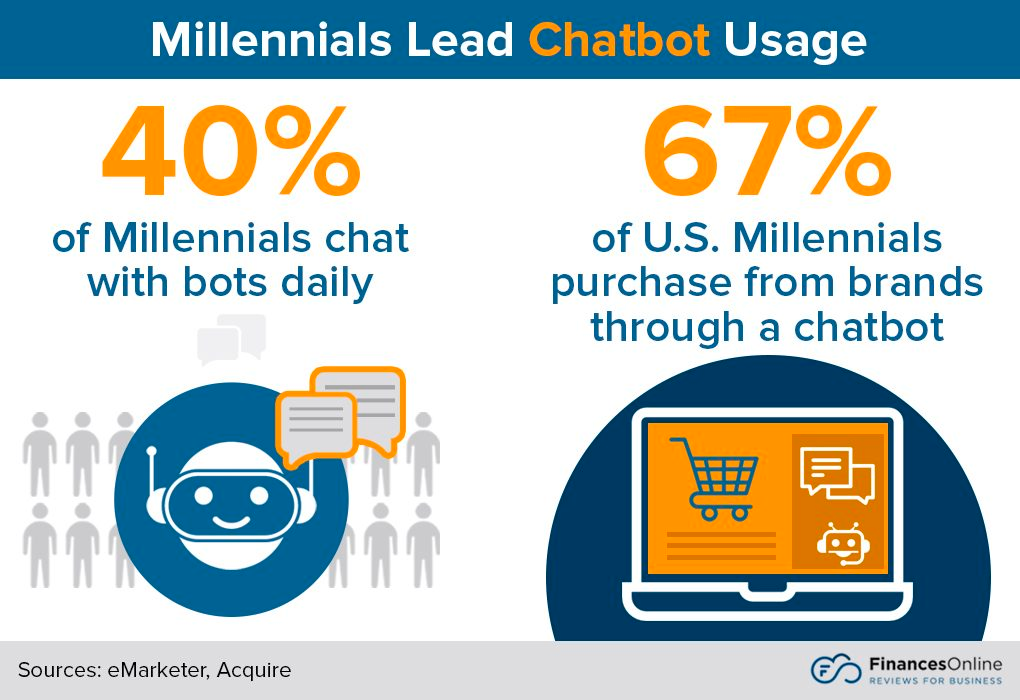What's the future of eCommerce? It's conversational commerce.
With the rise of human-to-human marketing, consumers of today want to make purchases from brands they can associate with. That’s where conversations fit in perfectly with eCommerce!
Conversational commerce is a hot, new trend that has many retailers and brands feeling excited. It's an online adaptation of fusing bricks-and-mortar sales techniques with eCommerce. It's also a way to leverage loyalty, connecting brands with their customers in a way that feels more personal and friendly.
How does conversational commerce work?
Conversational commerce is the ability of eCommerce stores to take a customer's experience to the next level.
Conversational commerce connects customers with your brand through messaging, chatbots, and AR/VR experiences. It helps retailers build a one-to-one relationship with their customers so they can provide better service and more personalized experiences.
For example -
- You can use conversational commerce to provide live help with product recommendations, product returns, and shipping details.
- You can also use conversational commerce to provide live assistance with scheduling appointments and managing your calendar.
- You can also use conversational commerce for general inquiries from customers who have questions about your products or services.
- You can even use conversational commerce as a way for customers who have purchased your products to ask questions about them in real-time!
You can leverage conversational commerce at every step of the customer journey including -
- Awareness
- Consideration
- Decision
- Retention
- Advocacy

Conversational commerce isn't just about reaching out to customers; it's also about building relationships with them in a more personal way. This can help you create stronger bonds with consumers, who will be more likely to buy your products if they feel like you're talking directly to them rather than just selling things to them.
Types of conversational commerce
1. Live chat

Live chat is one of the most common ways for brands to interact with their customers on their websites.
It's cheap and easy for both sides — most times, there's no app to download or signup required either — just a simple interface where you can type your message into an open box (or use an emoji). The other person on the other end of that conversation can then reply back in real time with an answer or response.
This is particularly useful for brands that want to offer 24/7 support without hiring additional staff members.
Also read - Complete Guide To Understanding Live Commerce in 2023
2. Chatbots

Chatbots are computer programs that mimic human conversation through written or spoken words. These bots use natural language processing and machine learning to understand the intent of a user and respond appropriately. This technology has been used in customer service for many years,
They're usually programmed to respond to specific questions or requests from users in order to help them accomplish tasks like scheduling appointments, ordering food delivery, or finding information about your product or service.
Chatbots can be implemented on your website as well as other messaging platforms like WhatsApp to deliver a stellar experience at different stages of the customer journey.
3. Messaging apps

Messaging apps allow users to chat with friends and family, but they can also be used to interact with businesses.
For example, Facebook Messenger allows users to send messages to businesses directly from the app or from an email address associated with a business account. The same is true for WhatsApp, which has over 1 billion active monthly users worldwide and allows any business with a phone number to receive inbound messages through its platform.
This gives you the opportunity to deliver personalized content, schedule appointments, or sell products directly from within the messaging app itself — all without requiring users to leave their social network or download another app in order to make a purchase.
Messaging apps are ideal for small businesses with limited resources and budgets because they are free and simple to implement.
4. Voice assistants
A common misconception is that voice assistants are just for home automation or the smart home. But these devices are quickly becoming an integral part of our daily lives, and they can be used in business as well.
Voice assistants are already being used for customer service and sales, but this is just the tip of the iceberg. Voice assistants can help you make sales, streamline your business processes and even help you find new customers!

Benefits of Conversational Commerce
Conversational commerce is not a new concept — it’s been around for several years now — but there are plenty of benefits that most people still don’t know about -
Reduce cart abandonment
You can reduce cart abandonment by using chatbots to help customers find what they want and answer questions about your products. If a customer wants to know more about something in your store, a chatbot can direct them to whatever information they require. This will lead to more sales as you make it easier for customers to stay engaged with your brand.
Convert potential leads much more easily
Conversational commerce offers a more personalized experience, which means that you can convert new leads into paying customers much more easily than before. For example, if a customer says “I’m interested in buying from you” or “How do I get started?”, your chatbot can respond by offering them options or directing them to relevant content. Understanding user intent is one of the most exciting aspects of conversational commerce!
Provide better customer service
Have you ever had problems ordering on an eCommerce site? You might encounter issues like slow shipping times or delayed responses from customer support teams who struggle with answering all of their messages at once. With conversational commerce, you can provide instant answers to any questions a customer might have — even if it’s just about how long it takes for their order to arrive at their doorstep.
Boosts upselling and cross-selling
Conversational Commerce allows you to engage your customers in a one-on-one conversation. This helps you understand their preferences and needs, which allows you to recommend the products that are most suitable for them.
It can help you reach out to customers who are not ready to buy yet and make them aware of your offers and promotions. It can also help you cross-sell products or services based on their previous purchase history or feedback.
Collect customer feedback
Conversational commerce is a great way to collect customer feedback and data in real-time, which can be used to improve your product or service, or even as sales opportunities.
For example, if a customer calls in with a question about their bill, you can use the call to understand what they like about your business and what they would like to see improved.
You can then take that information back to your team and use it to improve your products or services. This makes the customer feel heard and valued, which will lead to greater loyalty and retention.
Customer loyalty
The best thing about conversational commerce is that it improves the overall customer experience for your users by offering them convenience, ease, and speed of delivery. This makes them much more likely to return to your store again in the future as well as recommend it to friends and family members who are looking for similar items/products as well!
How to get started with conversational commerce
Conversational commerce is rapidly becoming the next frontier in eCommerce. But how do you get started?
Here’s a breakdown -
1. Understand your business needs
Before you begin any kind of conversational commerce campaign, it's important that you understand what your goals are and what benefits they will bring to your business. For example, if you're looking to increase sales or improve customer retention rates, then you may want to focus on providing more personalized recommendations based on previous purchases or browsing history.
If you're trying to improve customer satisfaction overall, then offering them more options for contacting customer support could go a long way toward making them happier with their experience with your brand.
2. Research, research, research
Before you start building a conversational commerce strategy, it's important to know what your customers want. You can't expect them to use your chatbot, for instance, if they don't see any value in using it!
And so, find out what your customers are interested in, what they're trying to accomplish, and how they want to interact with your business. This can be done through surveys, focus groups, or other forms of market research. Once you've gathered this information, it's time to develop strategies for engaging with these customers on a personal level.
You can begin building your conversational commerce strategy by thinking about how you want the customer interactions to flow.
- How will they initiate?
- What information do they need?
- How can they shop?
- What's the best way to answer their questions?
These are all important questions that should be asked before you start creating your chatbot or voice app.
3. Identify a partner
This can be a company that specializes in conversational commerce, but it's also possible to do the work in-house.
The most important thing is to find someone who understands your business and how your customers interact with both you and each other.
Here are some things to look for in a conversational solution:
- Reliability - The solution must be reliable, 24/7/365.
- Ease of use - The solution should be easy to use, with minimal training required for employees.
- Compatibility - It should integrate seamlessly into your existing eCommerce platform.
- Intelligence - The solution must be smart enough to understand your business needs, answer customer questions, and provide relevant recommendations based on real-time data analysis.
4. Launch your conversational commerce tool
You’re ready to launch your conversational commerce tool.
That’s great! Now what?
The next step is to get your customers started on the journey. How do they get started with your conversational commerce tool? What do they need to know?
If you have an existing website, you can link to your new chatbot from there. If not, you can use social media or other channels to promote the new feature.
Are you excited about conversational commerce? Do you want to learn more about this new and exciting eCommerce trend?
Conversational commerce is the next big thing in retail. It’s a new way of doing business that is more personal, engaging, and convenient for customers. And it’s not just another buzzword. Conversational commerce is already being used by leading companies across industries like travel, banking, and retail.
To learn more about all the new trends in eCommerce like conversational commerce, subscribe to our newsletter today!
Or contact us today.




